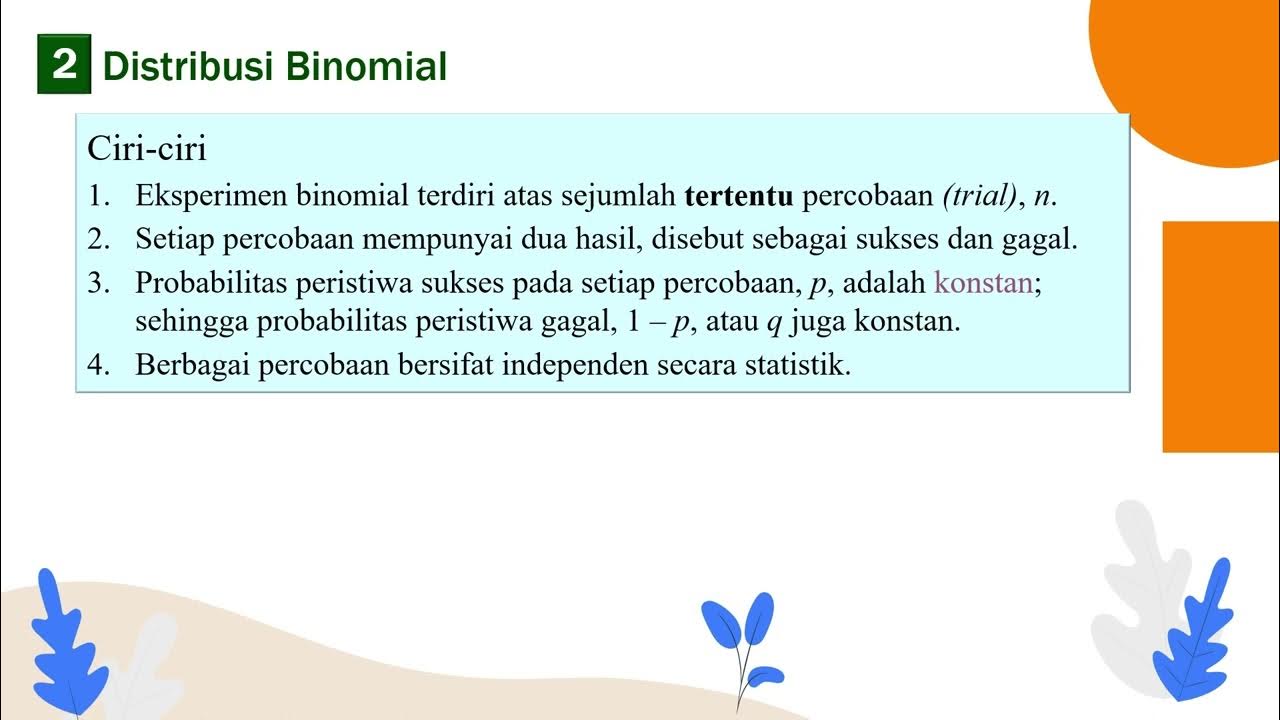Binomial distribution # Explanation with notes# Properties of binomial distribution.
Summary
TLDRThis video explains the concept of Binomial Distribution in statistics, detailing its classification as a theoretical probability distribution and its relation to discrete probability distributions. It discusses key concepts such as the binomial theorem, conditions for applying binomial distribution, and the formula used to calculate probabilities. The video also highlights the discovery of the distribution by James Bernoulli and provides insights into real-life applications. Various properties, such as mean, variance, and standard deviation, are also covered, along with the graphical representation of the binomial distribution in different scenarios.
Takeaways
- 😀 The concept of distribution in statistics is essential, with binomial distribution being a type of theoretical probability distribution.
- 😀 Distributions can be classified into two types: observed frequency distribution (based on actual data or experiments) and theoretical/probability distribution (based on assumptions and probability).
- 😀 Binomial distribution is a type of discrete probability distribution and comes under the theoretical category, based on the binomial theorem in algebra.
- 😀 The binomial distribution was discovered by Swiss mathematician James Bernoulli, and is sometimes referred to as Bernoulli distribution.
- 😀 Binomial distribution applies to experiments with two possible outcomes: success or failure.
- 😀 The formula for binomial distribution involves variables like X (number of successes), n (total trials), and p (probability of success in each trial).
- 😀 Conditions for applying binomial distribution include a fixed number of trials, mutually exclusive outcomes, constant probability of success, and independence of trials.
- 😀 The properties of binomial distribution include its dependence on the binomial theorem, and it can be represented graphically through discrete frequency distributions, often shown as line graphs.
- 😀 The shape of the binomial distribution graph depends on the value of p (probability of success). If p equals 1/2, the distribution is symmetric; otherwise, it is asymmetric.
- 😀 Key parameters of binomial distribution, such as mean and variance, can be calculated using specific formulas involving n and p.
- 😀 Binomial distribution is useful in real-life situations like gambling, manufacturing, or any scenario where there are two possible outcomes (success or failure).
Q & A
What is a binomial distribution?
-A binomial distribution is a theoretical probability distribution that describes the number of successes in a fixed number of trials, where each trial has two possible outcomes: success or failure.
How are different types of distributions classified in statistics?
-In statistics, distributions are classified into two main types: observed frequency distributions, which are based on actual data or experiments, and theoretical (probability) distributions, which are based on assumptions and expected frequencies.
What is the difference between observed frequency distribution and theoretical probability distribution?
-Observed frequency distributions are based on actual observations or experiments, whereas theoretical probability distributions are based on assumptions and mathematical models, using probability to estimate outcomes.
Which types of distributions are part of the theoretical probability distribution?
-The theoretical probability distribution can be further divided into discrete probability distributions, like the binomial and Poisson distributions, and continuous probability distributions, such as the normal distribution.
Who discovered the binomial distribution, and what is its alternative name?
-The binomial distribution was discovered by the Swiss mathematician James Bernoulli, and it is also known as the Bernoulli distribution.
What is the basic concept of binomial distribution?
-The basic concept of a binomial distribution involves an experiment with two possible outcomes: success or failure. The distribution models the probability of achieving a certain number of successes in a fixed number of trials.
What does the formula of the binomial distribution represent?
-The formula of the binomial distribution represents the probability of obtaining exactly 'x' successes in 'n' trials, where 'p' is the probability of success, and '1-p' is the probability of failure.
What are the key conditions required for applying the binomial distribution?
-The binomial distribution can be applied if the number of trials is finite and fixed, each trial results in mutually exclusive outcomes, the probability of success is constant across trials, and the trials are independent.
What are some real-life applications of binomial distribution?
-Binomial distribution is used in real-life situations such as gambling, coin tossing, manufacturing quality control, and other scenarios where there are two possible outcomes (success or failure) in repeated trials.
What are the key properties of binomial distribution?
-Binomial distribution is based on the binomial theorem, and it is a discrete probability distribution. The theoretical frequency can be calculated by multiplying the probability of success by the total number of trials. The distribution's graph can be presented as a line graph showing the number of successes on the x-axis and the probability on the y-axis.
Outlines

Этот раздел доступен только подписчикам платных тарифов. Пожалуйста, перейдите на платный тариф для доступа.
Перейти на платный тарифMindmap

Этот раздел доступен только подписчикам платных тарифов. Пожалуйста, перейдите на платный тариф для доступа.
Перейти на платный тарифKeywords

Этот раздел доступен только подписчикам платных тарифов. Пожалуйста, перейдите на платный тариф для доступа.
Перейти на платный тарифHighlights

Этот раздел доступен только подписчикам платных тарифов. Пожалуйста, перейдите на платный тариф для доступа.
Перейти на платный тарифTranscripts

Этот раздел доступен только подписчикам платных тарифов. Пожалуйста, перейдите на платный тариф для доступа.
Перейти на платный тарифПосмотреть больше похожих видео
5.0 / 5 (0 votes)






